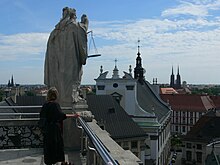Franz Joseph Mangoldt

Franz Joseph Mangoldt (also Franz Josef Mangoldt ; last name also Mangold ; * 1695 probably in Brno ; † 1761 ) was a German baroque sculptor who worked mainly in Silesia from 1725 .
Life
Franz Joseph Mangoldt's life dates are not exactly known. Presumably he was the son or another relative of the Brno sculptor Joseph Mangold ( Mangolt ), who came from Rottenbuch in Pfaffenwinkel in Bavaria . This is documented for the first time in 1694 in Brno and in 1700 was a member of the St. Luke Brotherhood there. Another relative was probably Johann Mangold, who created the sculptural furnishings for the St. Anne's Church in the Moravian Nikolsburg around 1710 .
Franz Joseph Mangoldt's best-known works include the decorative furnishings of the Wroclaw Aula Leopoldina , the prince's hall in the Cistercian monastery Leubus , works for the monastery Trebnitz and the parish churches in Leubus and Seitsch . His artistic colleagues included Johann Christoph Handke , Christian Philipp Bentum , Johann Albrecht Siegwitz and Felix Anton Scheffler . He created his sculptures mainly from stucco marble that was poured over a brick framework.
Franz Joseph Mangoldt was married to a daughter of the Schweidnitz sculptor Georg Leonhard Weber . Mangoldt's daughter was married to the painter Johann Heinrich Kynast , who was presumably a student of his. Other pupils of Mangoldt were Ignaz Axter and Franz Anton Felder († 1782).
Works (selection)
-
Wroclaw
- St. Adalbert , Ceslauskapelle: Contribution to the sculptural equipment (1725)
- Jesuit Church of the Sacred Heart of Jesus (from 1819 parish church of St. Matthias): Franz Xaver altar made of stucco marble, two alabaster reliefs with scenes from the life of St. Franz Xaver, Trägerermohr, ornamental filling of the wall surface (1725–1733); Pulpit made of marble and wood (1727/28)
- Main building of the then Jesuit University of Wroclaw :
- Aula Leopoldina : Statues of Emperors Leopold I , Joseph I and Karl VI. and allegorical figures (1731–1733);
- Oratorium Marianum : rich carving (1732)
- Sandstone statues of the four faculties ( theology, philosophy, medicine and law ) on the mathematical tower (1733)
- Sand church : stucco marble pulpit with reliefs and two larger than life support pods (1739)
- St. Elisabeth : Tomb for Johann Christoph Neumann and his wife (after 1733; attributed )
- Dorotheenkirche : tomb of the episcopal court chancellor Heinrich Gottfried von Spätgen (1752/53)
- Former summer palace of the Breslau bishops ( Websky-Schlösschen ): stucco work of the interior (1749/50)
-
Leubus
- Leubus Monastery : Interior of the Princely Hall with marble encrustation of the walls and stucco group of Emperors Leopold I, Josef I and Karl VI. with mythological and allegorical figures; Moorish portal (1734–1738) and garden sculptures (around 1739)
- Parish church of St. Valentin ( vineyard church ): Figures of the high altar, crucifixion and St. Mary's altar and pulpit (1740–1745). Out of gratitude to the Leubus Monastery, he created the sculptural decoration of the St. Nepomuk Chapel in the parish church, for which Christian Philipp Bentum, also free of charge, created the altarpiece “Martyrdom of St. Johannes von Nepomuk ”and the painting“ Confession of the Bohemian Queen ”.
- Seitsch , parish church St. Martin : high altar with figures of St. Petrus, Paulus, Ambrosius and Augustinus as well as St. Benedict and Bernhard; Pulpit with scenes from the New Testament, on the sound cover "Christ the Redeemer" and putti with symbols of the four church fathers (1738–1740)
- Trebnitz Monastery : high altar with the figures of St. Bartholomäus, John the Baptist, John the Evangelist and Judas Thaddäus (1747/48); Pulpit with figure of the risen Christ on the sound cover; Figures of St. Hedwig and Elisabeth at the Triumphal Arch (1739–1745); Alabaster figure of St. Hedwig in front of her grave monument (1750/51)
literature
- Mangold, Franz Josef . In: Hans Vollmer (Hrsg.): General lexicon of fine artists from antiquity to the present . Founded by Ulrich Thieme and Felix Becker . tape 24 : Mandere – Möhl . EA Seemann, Leipzig 1930, p. 14-15 .
- Dehio Handbook of Art Monuments in Poland. Silesia. Deutscher Kunstverlag, Munich et al. 2005, ISBN 3-422-03109-X , pp. 58, 66, 70, 564, 566 f., 833, 960 f., 1047, 1059, 1068, 1979 f. and 1139.
Individual evidence
- ↑ Beata Lejmann: Philip Christian Bentum malarz Śląskiego baroku . Wydawnictwo Neriton, Warszawa 2008, ISBN 978-83-7543-033-2 , p. 36, footnote 108.
- ↑ Both pictures were stolen in 1979; s. on this Beata Lejmann ..., p. 215
| personal data | |
|---|---|
| SURNAME | Mangoldt, Franz Joseph |
| ALTERNATIVE NAMES | Mangold, Franz Joseph; Mangoldt, Franz Josef |
| BRIEF DESCRIPTION | German sculptor |
| DATE OF BIRTH | 1695 |
| PLACE OF BIRTH | uncertain: Brno |
| DATE OF DEATH | 1761 |

